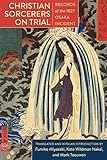Christian sorcerers on trial : records of the 1827 Osaka incident / translated and with an introduction by Fumiko Miyazaki, Kate Wildman Nakai, and Mark Teeuwen.
Material type: TextLanguage: English Original language: Japanese Publisher: New York : Columbia University Press, 2020Description: 1 online resourceContent type:
TextLanguage: English Original language: Japanese Publisher: New York : Columbia University Press, 2020Description: 1 online resourceContent type: - 0231551886
- 9780231551885
- Martyrdom -- Christianity
- Osaka (Japan : Prefecture) -- Church history -- To 1868
- Osaka (Japan : Prefecture) -- History -- 1600-1868
- Martyre -- Christianisme
- Ōsaka (Japon : Fu) -- Histoire religieuse -- Jusqu'à 1868
- HISTORY / Asia / Japan
- Martyrdom -- Christianity
- Japan -- Osaka (Prefecture)
- To 1868
- 272/.90952 23
- BR1310.O7
- online - EBSCO
| Item type | Current library | Call number | URL | Status | Notes | Barcode | |
|---|---|---|---|---|---|---|---|
 eBook
eBook
|
Biblioteca "Angelicum" Pont. Univ. S.Tommaso d'Aquino Nuvola online | online - EBSCO (Browse shelf(Opens below)) | Online access | Not for loan (Accesso limitato) | Accesso per gli utenti autorizzati / Access for authorized users | (ebsco)2272010 |
Includes bibliographical references and index.
"In 1829, three women and three men were paraded through Osaka and crucified. Placards set up at the execution ground proclaimed their crime: they were devotees of the "pernicious creed" of Christianity. Middle-aged widows, the women made a living as mediums, healers, and fortune-tellers. Two of the men dabbled in divination; the third was a doctor who collected books in Chinese on Western learning and Christianity. This was a startling development. No one in Japan had been identified and punished as a Christian for more than a century, and now, avowed devotees of the proscribed sect had appeared in the very heart of the realm. Just decades before the arrival of Perry's black ships and the fall of the Tokugawa shogunate, the incident reignited fears of Christians as evil sorcerers, plotting to undermine society and overthrow the country. Christian Sorcerers on Trial offers annotated translations of a range of sources on this sensational event, from the 1827 arrest of the alleged Christians through the case's afterlife. The protagonists' testimonies relate with striking detail their life histories, practices, and motivations. The record of deliberations in Edo and communications between Osaka and Edo officials illuminate the operation of the Tokugawa system of criminal justice. Retellings of the incident show how the story was transmitted and received. Translated and put in context by Fumiko Miyazaki, Kate Wildman Nakai, and Mark Teeuwen, the sources provide students and scholars alike with an extraordinarily rich picture of late Edo social life, religious practices, and judicial procedures"-- Provided by publisher.
Description based on print version record and CIP data provided by publisher; resource not viewed.
Frontmatter -- CONTENTS -- ACKNOWLEDGMENTS -- KYOTO MAP KEY -- OSAKA MAP KEY -- INTRODUCTION -- TRANSLATION STRATEGIES -- MAIN PROTAGONISTS -- Part I. TESTIMONIES -- Part II. THE JUDICIAL REVIEW PROCESS -- Part III. RUMORS AND RETELLINGS -- Appendix 1. Mitsugi's 1822 Arrest -- Appendix 2. Disposition of the Proscribed Books -- Appendix 3. Manuscript Versions of the Keihan Kirishitan Incident Dossier -- GLOSSARY -- NOTES -- REFERENCES -- INDEX


